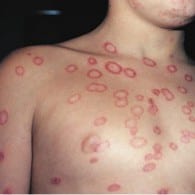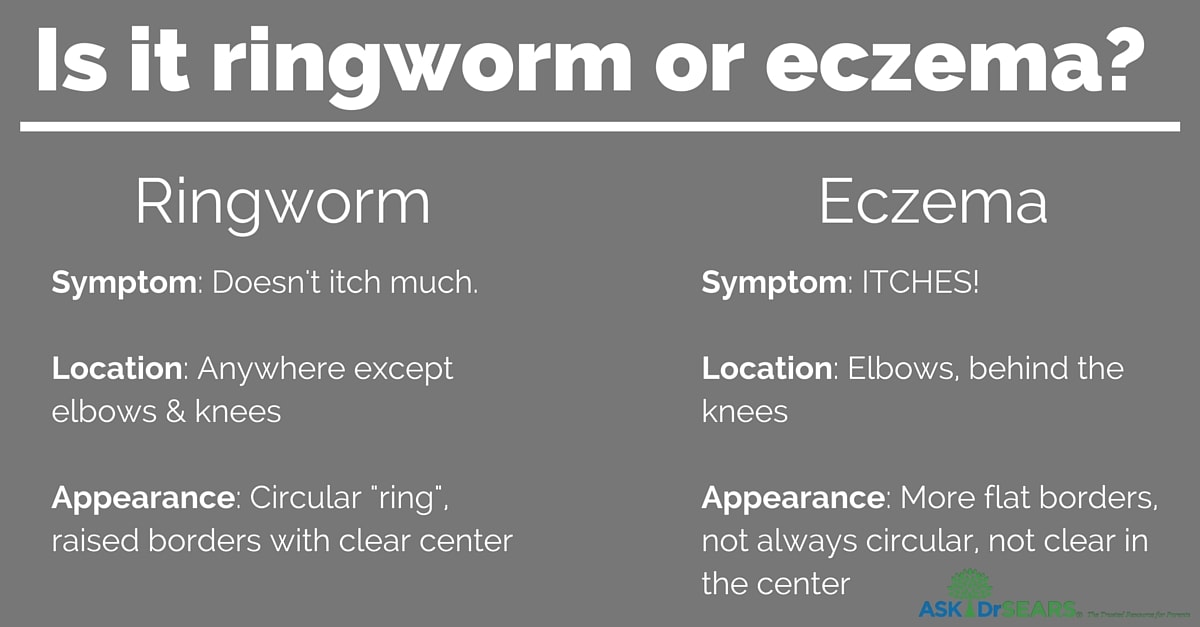Causes, Symptoms and Treatment for Ringworm
You are giving your three-year-old a bath when you notice a strange, ring-shaped rash on his back approximately the size of a silver dollar. It wasn’t there a few days ago. What is this strange round spot? It may be ringworm – a harmless skin condition that is easily treatable. Here is a guide to diagnosing and treating this very common rash.
What causes ringworm?
Although the name suggests a parasitic type of worm as the culprit, it is actually caused by two common, and harmless, fungi called Trichophyton and Microsporum.
Where did my child catch it from?
The fungi in the rash are contagious by direct contact with the rash or from the hands of an infected person who has been scratching the rash. Your child can also catch it from infected pets, especially dogs and cats.
What does ringworm look like?
The lesions are round and slightly red, with a border of small scales, blisters, or bumps. The lesions are well demarcated, which means there is a very sharp border between the infected and normal skin. The center is often clear, almost normal appearing, skin. The lesions vary in size from dime-sized up to several inches across. It is usually found on the face, trunk or limbs.
Several close lesions can merge together, forming a multi-lobed appearance.
A general rash of fine, red bumps can appear elsewhere on the body – this is an allergic reaction to the fungus that causes the rash.
Does ringworm itch?
Yes, usually your child will scratch at the spots. This also increases the chance of him spreading it to other kids with his hands.
Is ringworm dangerous?
No! Serious cases of ringworm are virtually unheard of. This is a mild condition that is easily treatable.
How is ringworm diagnosed?
It is easily identifiable by your doctor simply by visual inspection of the rash. If your doctor is unsure of the diagnosis, a scraping of the lesion can be examined under a microscope to check for the fungus, although this is often difficult to do and the fungus can be hard to find.
What other conditions appear similar to ringworm?
There are several other skin conditions that can mimic the ring-like appearance of ringworm. None of these, however, are serious. They include eczema, contact dermatitis, psoriasis and seborrhea. If treatment for ringworm fails, your doctor may consider these other possibilities.
How do I treat ringworm?
It is easily treated by topical anti-fungal creams. The standard treatment is over-the-counter clotrimazole (brand name Lotrimin or Mycelex) applied twice a day to the lesion and surrounding skin. There are many other over-the-counter and prescription creams that are also effective. Ask your doctor for a recommendation.
How long do I treat ringworm?
You may not see any improvement in the rash for several days. In some cases, it takes two weeks before you will see any change. Treatment should continue for two to four weeks total, depending how quickly the rash initially improves.
Can I treat ringworm without consulting my doctor?
Yes you can. The treatment is very mild. If the lesion is not ringworm, the anti-fungal creams generally have no ill-effects on any of the other possible conditions. If the rash does not improve, however, after 2 weeks of treatment, you should consult your doctor.
Does my child need to stay home from school until the rash clears?
Although it is contagious by close, direct contact with the rash, the casual contact experienced at school is rarely enough to transmit the disease. Your child can continue to attend school.
Is It Ringworm or Eczema?
Ringworm is not always easy to tell from other skin conditions, such as pityriasis rosea, psoriasis, or contact dermatitis. Ringworm can often be confused with eczema, since eczema can also manifest itself on the body in a ring-like nature. Here is a quick way to tell the difference between ringworm and eczema:


